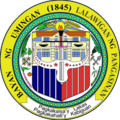Umingan | |
|---|---|
| Municipality of Umingan | |
 Downtown area | |
 Map of Pangasinan with Umingan highlighted | |
Location within the Philippines | |
| Coordinates: 15°55′44″N120°50′31″E / 15.9289°N 120.8419°E | |
| Country | Philippines |
| Region | Ilocos Region |
| Province | Pangasinan |
| District | 6th district |
| Founded | May 5, 1843 |
| Barangays | 58 (see Barangays) |
| Government | |
| • Type | Sangguniang Bayan |
| • Mayor | Michael M. Cruz (NP) |
| • Vice Mayor | Chris Evert B.Tadeo-Leynes (API) |
| • Representative | Marlyn L.Primicias-Agabas |
| • Municipal Council | Members |
| • Electorate | 56,451 voters (2025) |
| Area | |
• Total | 258.43 km2 (99.78 sq mi) |
| Elevation | 115 m (377 ft) |
| Highest elevation | 561 m (1,841 ft) |
| Lowest elevation | 70 m (230 ft) |
| Population (2024 census) [3] | |
• Total | 78,940 |
| • Density | 305.5/km2 (791.1/sq mi) |
| • Households | 20,380 |
| Economy | |
| • Income class | 1st municipal income class |
| • Poverty incidence | 18.99 |
| • Revenue | ₱ 349.6 million (2022) |
| • Assets | ₱ 549.2 million (2022) |
| • Expenditure | ₱ 334 million (2022) |
| • Liabilities | ₱ 153.2 million (2022) |
| Service provider | |
| • Electricity | Pangasinan 3 Electric Cooperative (PANELCO 3) |
| Time zone | UTC+8 (PST) |
| ZIP code | 2443 |
| PSGC | |
| IDD : area code | +63 (0)75 |
| Native languages | Pangasinan Ilocano Tagalog |
| Website | www |
Umingan, officially the Municipality of Umingan (Pangasinan : Baley na Umingan; Ilocano : Ili ti Umingan; Tagalog : Bayan ng Umingan), is a municipality in the province of Pangasinan, Philippines. According to the 2024 census, it has a population of 78,940 people. [5]



